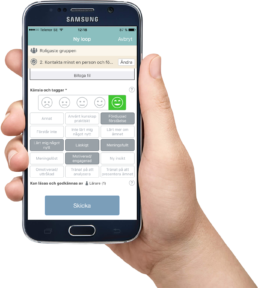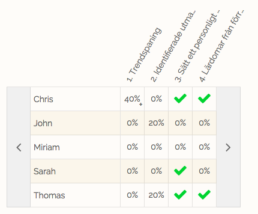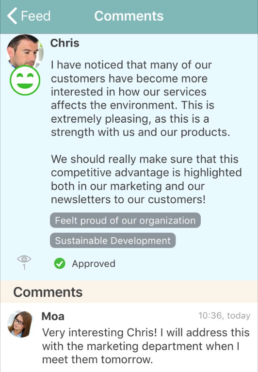LOOPME FOR RESEARCHERS AND EVALUATORS
How to collect trustworthy and relevant data?
Data collection from respondents is a key activity in social science research and evaluation. The quality of the data collected in surveys and interviews is crucial to the answers that research or evaluation can give. There is often a choice between using quantitative methods that enable statistical analysis or using qualitative methods that provide good opportunities for exploring more complex issues.
Collecting and analyzing data is often difficult and time-consuming. Many rigorous quantitative survey methods provide relatively low relevance to society. Qualitative interview and observation methods are often of greater relevance to practitioners, but often fail to provide reliable and generalizable results. Many researchers and evaluators find it difficult to find a versatile method of collecting data. If you recognize these challenges, LoopMe is probably something for you.
Three benefits of LoopMe for researchers and evaluators
By using LoopMe as a tool for data collection, you achieve three key benefits: clarity, improved data, and automation.
Clarity
Clarity increases with LoopMe since all respondents get a clear overview of both expected actions and possible outcomes directly from their daily leader. Respondents see exactly what actions are expected of them.
Improved data
LoopMe gives you, as a scientist, a unique opportunity to get insider access to the practitioners’ own trustful dialogues in digital form, producing high-quality research data as they discuss issues of central importance to them.
Automation
LoopMe transfers the responsibility for collecting data to the respondents themselves, saving valuable time for you as a researcher. Once LoopMe is deployed among practitioners, your research data will automatically transfer to you.
WHAT OUR CUSTOMERS TELL US
Users love the unique insights and competitive cost
The researchers and evaluators using LoopMe to collect and analyze data state that the level of detail and confidentiality of the reflections sent by respondents to their leaders presents a unique insight into social processes. The many opportunities to quantify respondents’ experiences also facilitate the analysis. Project evaluations using LoopMe contain deep insights from more respondents than other methods can provide, and also benefit from a competitive cost for the data collection activities.
High-quality research
Research carried out with LoopMe has been published in many scientific journals, including many top-ranked journals. Award-winning research has also been conducted based on data collected with LoopMe.
A promising and innovative method
The method behind LoopMe has attracted attention among researchers around the world and is considered very promising. It could potentially transform data collection as we know it.


CLARITY
LoopMe clarifies what is desirable and interesting
With LoopMe, key research questions can be made clear to all respondents and continuously monitored longitudinally over time. Together with their leader, you specify a number of actions that respondents are expected to perform. This clarifies those behaviors that are interesting to study as well as triggers action and subsequent deep reflection among respondents. LoopMe contains predefined actions to choose from, and you can also create completely customized actions that the leader submits to respondents. You can easily follow the respondents’ actions and reflections in real time via the live feed and summary matrices.
On the browser, or via the app, the respondents get a smooth overview of their assigned and completed action assignments. Once an action has been completed, they quickly send a report to their leader as well as to you as a researcher. Each report contains a personal reflection, an emoticon, and a categorization using different tags that indicate progress and challenges.
"This ability to engage in experience sampling offers a powerful way to collect information on entrepreneurial activity and holds great promise as a research method. "
— William Gartner, Professor, Babson College


BETTER DATA
LoopMe collects in-depth and honest data
As a researcher, you can deploy a communication platform among practitioners that they benefit from in their everyday work-life. The data generated becomes both more in-depth and more honest than if the respondents had answered regular questionnaires or participated in interviews. LoopMe thus gives you access to the deep and unique confidential dialogues that practitioners have with each other on matters of great relevance to both them and your research. Through ingeniously formulated assignments that merge action with guided reflection, the digital conversations become focused on precisely those issues that are of most interest to you.
Because each reflection is written immediately after an assigned action has been completed, the live feed that you, as a researcher, follow on the browser or in the app, becomes more relevant. You can also join the dialogue if the situation allows, via a comment thread on each report. Since LoopMe keeps track of which respondents have completed specific action assignments, you can frequently achieve response rates close to 100%.
"We are using LoopMe to study what happens when research and practice meet. What challenges arise, what opportunities are there?"
— Helén Viebke, action researcher at Åstorp municipality


AUTOMATION
LoopMe simplifies documentation and facilitates analysis
With LoopMe, responsibility for data collection is transferred from you as a researcher to the leaders and respondents who participate in the environment you study. Mandatory reflections on well-thought-out issues of high relevance to your research ensure that important insights, advances, and challenges are recorded and highlighted for your research team.
Since emotion categorization and category tags always need to be specified in each report, you quickly get an overview of the data collected through LoopMe. You can easily capture moods among groups of respondents by looking at emotion icons and tags, and the in-depth analysis is facilitated by statistics based on these estimates. Trends can also be analyzed both in real time and afterwards. The effects of different actions by respondents are clearly measurable and comparable.


